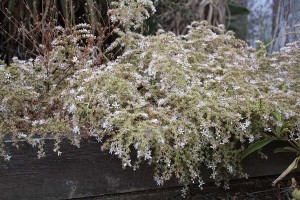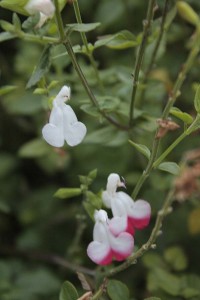It’s been a cool summer so far, following on the heels of a sunny but cool spring. I’ve been watching the temperatures in the paper for Fairbanks, Alaska, and most days the official San Diego report has been cooler. In fact it’s been cooler than almost anywhere in the US except for maybe Anchorage in Alaska. Brr.
At my July 4th party I was talking to someone there with ties to the Scripps Institution of Oceanography, and his thoughts were that this is typical for an El Niño year. The phenomenon that the locals call “May gray” would be slow to get started (as was the case this year), and the dreaded subsequent phenomenon the we call “June gloom” would drag on longer than usual. All that seems to be happening.
The garden natives don’t seem to be worrying about the temperature as much as I’ve been. In fact the late-spring bloomers seem to be having a field day, extending their bloom, looking nice at a time of year when they don’t always. Black sage is often done by this time, but there are a few lingering flowering stems.
For stunning flowers, though, the black sage has passed the baton to Cleveland sage. Here’s the common and gorgeous cultivar ‘Winnifred Gilman.’
…and here’s Winnifred in closeup…
One of local live-forevers, Dudleya edulis, has had one of the more amazing years that I can remember. Here’s an 18-20 year old plant from above, all covered with flowers. In this photo it’s sprawling six feet across from one edge to the other.
The same dudleya, viewed from ground level as it cascades over a short little retaining wall.
The San Miguel Island buckwheat that I grew from seed two years ago, Eriogonum grande var. rubescens, is finally hitting its stride, finally looking the photos I’ve seen in books. Maybe the cooler weather will keep it looking nice longer.
Among the many non-natives that call my garden their home, this is Clerodendrum ugandense, finally perking up after looking like a twig until late in May. I think it’s been a somewhat slow start for this plant this year, but it always waits until the weather warms to look like a plant you want to keep in the garden.
The common ornamental sage, Salvia ‘Hot Lips,’ is grown for its red and white bicolored blooms. I’ve heard that it blooms mostly with white flowers when weather turns cold. In the left photo these are the only two red and white flowers I could find on three plants. The rest of the flowers are white. In the depths of winter, however, this plant is often completely bicolored, so I’m not sure if there’s any truth to this color change rumor.
Some of the plants that I worry about the most are my American pitcher plants, these Sarracenia from the South, where the daily low temperatures these days are often running ten degrees above the San Diego daytime highs. Fortunately these plants seem to respond more to daylength than to temperature, and the plants look pretty good. Still, they might be taller by now where they originate.
Cool as the days may be, one thing told me for sure that I do not live remotely near Alaska. Monday night was the grand opening of the first giant bloom of this climbing cactus, probably Hylocereus undatus. Even if it’s probably been slow getting started this year, it’s probably the best proof that I’m overreacting. Hardy to not much below freezing, one hit of arctic cold and you’ll freeze this plant’s tuchas off.
At eight to ten inches across, the only shy thing about this plant is that it only opens as darkness approaches. People in cold climes covet being able to grow plants like this–or in fact many of our more tender California natives.
That’s definite proof, Dorothy. We don’t live in Alaska. It just might feel that way these cool summer days.












It is actually raining in OC today! Waiting patiently (kind of) for summer!
Cold?!? Oh, you coastal dwellers. If you need to warm up, just drive inland a little way and you can experience 105-degree temperatures like the rest of us. Why you’d want to, though, I can’t imagine.
I would never have guessed that that was a Dudleya. It looks very different from the ones up here. And I’m constantly admiring your wide variety of sages. The only sage native within 50 miles of here, and the only one that’s managed to survive so far in my yard, is Salvia sonomensis. I’m glad that at least I can grow that one sage, but disappointed that it doesn’t seem likely that I’ll ever be able to grow any of the others.
Sheila, I got pretty drizzled on this morning on my scooter on the way to work. People are talking about how strange all this is–and then we had that little earthquake this afternoon to make things even more strange.
Gayle, okay, I’m whining a little. The desert, just an hour and a half to east, is well over a hundred, so there’d be an easy way to warm up. I’m sure we’ll get our heat waves eventually. Salvia sonomensis does grow here, though it’s a little on the touchy side. (The hybrid Bee’s Bliss is part sonomensis but seems to do better near the coast.) As far as the dudleya, it’s a pretty distinctive one. The rarer D. viscida has a somewhat similar look. I’m thinking about a little collection of some of the various dudleyas. They’re neat plants.
Roger that…we are definitely cold here in Anchorage. We’re always colder than Fairbanks in the summer but they are colder in the winter.
I have none of the plants you mentioned (and pictured) so you are most certainly not gardening in Alaska. It’s usually very pleasant in the summer in the low seventies but right now I am wearing a sweater and have a wool blanket draped over my shoulders. We could use ten degrees of heat right now…maybe Arizona could send us both some?
Christine in Alaska
Hey, send some of that weather my way, and I will return the favor with some of our 102-103 degrees. The weather is having an effect here too – my nasturtiums are now toast!
Eriogonum grande var. rubescens and Cleveland sage are two of my favorite dry garden plants. Have you noticed some people love the smell of Cleveland sage and even cut it for indoor arrangements, while other people can’t stand the smell? I like it, although I wouldn’t go out of my way to run my fingers through it or anything.
cold. How nice that would be – but I’m speaking from the 100-degree east coast!
Love all that salvia. The dudleya is really pretty too – I like how it spills over the wall. the hot lips are really cool. Keep us posted on the color-changing!
James, We in the northeast would be happy to send you (and Christine) some of our excess heat. My late summer flowers are already starting to bloom, and many of my plants are looking as hot and wilted as I feel. (I know, Gayle, we’re sissies here in Maine to complain about temps in the eighties and low nineties, but we mostly don’t have ac.) They’re promising us rain and a cooling trend for tomorrow.
Jim,
Not to worry about your sarracenia! When I lived in Georgia I got into the amazing pitcherplant bogs they had at the UGA and Atlanta Botanical gardens. Both those areas are routinely subjected to winter freeze, including an occasional snow. Also having grown certain cultivars in W Washington with a decent amount of success, I’m more worried about how you’ll fare. Can you say “Hot house flower”? 🙂
Christine, so Anchorage is also having a “colder than Alaska” season? Hopefully you get some warmth to go with your manically long days this time of year. Recharge your batteries for the dark and cold ahead!
SwinRay, since nasturtiums are edibles, I wonder what toasted nasturtiums would taste like? Probably not great on a salad… Stay cool.
Susan, I’m one of those people who has to pet the sage plants. The cleveland and white sage in the front yard, the black and purple in the back–they all get my fingers run over them to sample how great they smell. I’ll have to admit that when I cut the bouquet Saturday night I almost had to take the thing outside because the sage scented up most of the house. Too much of a good thing for me…
Wendy, I missed a spot on the three salvia plants, the side facing south. Of all the sides, it was the only one with red and white flowers in any abundance. So there might something to be said for warmth and coloration.
Jean, we don’t have A/C either, and neither do many of our neighbors. Most years we get less than a week of weather where A/C would make life more bearable, so it’s not worth the time or space or expense. And one neighbor with an air conditioner has never run theirs. I think we just get used to a certain temperature range, and anything outside it for long starts to wear. I’m glad to report things have warmed up now that I’ve whined about it. I’m glad the weather gods read my blog.
Colleen, yah, I guess I’m a little spoiled most of the time! I’m not sure why but there seems to a big concentration of carnivorous plant vendors in the more coastal Pacific Northwest. The longer days must offset the shorter growing season somehow, even if the temps almost never get close to Florida or Georgia. And even Washington is a mild climate for the northern subspecies of S. purpurea, so I don’t doubt their ability to withstand cold. It’s just the deprivation of warm summers that I worry about–both for the plants and me.
We are only too glad to be having cool foggy mornings with lots of fog drip to keep the fire danger low. I also observer extended bloom periods this year. Today though – July 15 – sunny and warm. It is a nice change I do admit!
I think your blog is fantastic, I will be a regular visitor.Probably Summer here in Aberdeen Scotland is cooler than it is in your part of the world, but I love it. Average temperature here in July/August is in the region of 17c however we do often get in excess of 22c which feels fantastic. After reading your blog, I am considering a change in my style.
CM, it’s good the fire danger is down. I appreciate that here too. And it’s nice that I don’t have to water as much. Since I wrote this we actually had two days of full-on summer. People were wilting. But now we’re back to the cool days. We’ll get summer eventually, even if it takes until fall to get here…
Alistair, thanks for stopping by from so far away and for the nice comments! I have two cousins who just returned from a vacation in Scotland and had a great time there. One of them is a gardener who came back with lots of wonderful plant and garden photos. Your coolness gives you some stunning plant options that wouldn’t do well here.